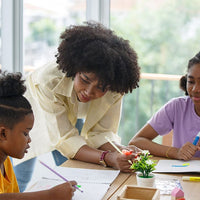
Five Ways to Use Silence to Build Learning
The great American philosopher Mister (Fred) Rogers once said, “Silence is one of the greatest gifts we have.” Fortunately, this gift is free and available to all of us. However, silence can feel uncomfortable, even awkward, if we are not accustomed to it or fail to appreciate its value.
Despite its sometimes negative connotation, silence actually offers many learning and health benefits. For example, extended silence has been shown to lead to the creation of new brain cells associated with learning and recall. Silence can help us to increase and extend our ability to focus. It can also lower blood pressure and increase blood flow to the brain, thus lowering stress and relieving tension. The key is to find time and create conditions where silence can be experienced.
At the same time, we know that learning can often be loud and boisterous, especially when it generates excitement. Making sense of new information may require discussion, lead to questions, and stimulate the sharing of observations. Obviously, these are important components of learning, yet learning also grows with reflection, contemplation, context finding, and connection making.
The rapid pace of the school day can make finding time for and utilizing silence a challenge. We can feel the urge to fill each second of the day with words, activity, and other features in our efforts to keep students focused and occupied. Nevertheless, there are many opportunities for us to create and utilize silence to calm, guide, and support learning. Consider these five ideas that leverage the value of silence to engage students.
- Look inside. We might begin our class period by providing students with a few minutes to silently gauge and reflect on their emotions. During stimulating discussions or insightful conversations, we can give students a few moments to silently explore their thoughts. We can encourage students to take deep breaths and engage in other relaxation and reflection techniques. This focus likely will open doors to discussion about how our students are feeling and how they imagine others might be feeling. We could then follow the period of silence with a discussion about how they can direct their emotions and energy in a positive and productive direction.
- Clear your mind. Before beginning a new cycle of teaching and learning, we might invite students to pause, relax, and clear their minds of distractions and preoccupation. We can direct them to consciously let go of what may get in the way of what they will learn next.
- Consider what you already know. As we introduce new content or a new skill, we might ask students to think about what they are going to learn. We can encourage students to take some time to think about what they already know. They could jot down notes for themselves or post thoughts in a virtual common space for later discussion. We need to give plenty of time and encourage them to think beyond their initial recollections. For example, what might be related? Of course, we also can ask what else they would like to know.
- Hold that thought. Pausing after asking a question and allowing students to think before calling on someone to respond is a common and effective strategy for encouraging more thought and more students to respond. For students who are typically reluctant to respond in the presence of other students, we might signal that we will be calling on them in advance to help them be prepared to answer. It can be a great confidence builder.
- Imagine what it looks like. When we pose a question, we can shift students’ attention away from immediately verbalizing answers and toward developing responses using pictures, graphics, maps, or some form other than words. We may need to allow students several minutes to silently draw, compose, and develop a graphic representation that fully reflects their thinking. This approach allows students who are not quick thinkers, verbally skilled, or outgoing to reflect and think while employing other forms of expression in a context of silence.
In a world filled with noise, silence can be both a welcome relief and an uncomfortable, vacant space. Yet, the more we create and utilize silence to support learning, the more our students will appreciate its value and become comfortable in its presence. Meanwhile, the silence we experience can improve our thinking, our mood, and our health.

Take Your District and School Professional Learning to a New Level!
learn more
- Teachers
- Administrators
- Paraeducators
- Support Staff
- Substitute Teachers

- Teachers
- Administrators
- Paraeducators
- Support Staff
- Substitute Teachers






Leave a comment
Your email address will not be published. Required fields are marked with *